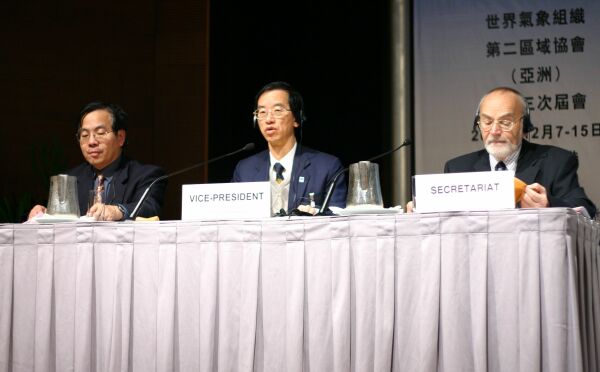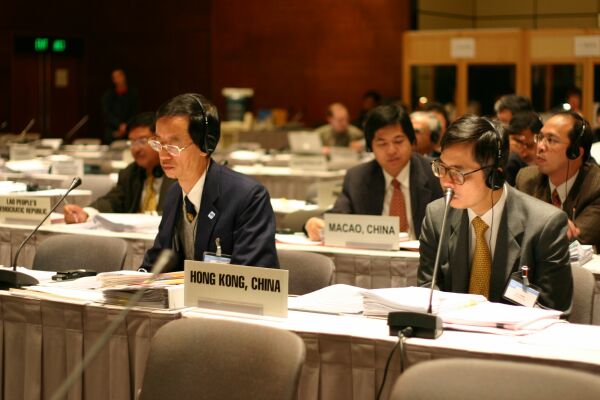Director of HKO re-elected vice-president of WMO Asian group
Director of HKO re-elected vice-president of WMO Asian group (15 December 2004)
|
The Director of the Hong Kong Observatory, Mr C Y Lam, was re-elected vice-president of Regional Association II (Asia) of the World Meteorological Organization (WMO) which just had its 13th session in Hong Kong. Mr Lam said his re-election reflected the trust of the Asian countries in the Hong Kong Observatory and the high esteem of Hong Kong in the world meteorological community.
The number of delegates attending this session was a record for the association. During the session, Hong Kong was highly regarded by delegates both as the host and an WMO member which had contributed good ideas to promote the development of meteorological services in the region.
The World Weather Information Service (WWIS) and the Severe Weather Information Centre (SWIC) websites developed and operated by the Observatory on behalf of WMO received high acclaim from delegates, for being a unique and highly visible official source of weather, forecasts for cities and severe weather warnings around the world.
The session adopted a Strategic Plan for the Enhancement of National Meteorological Services in Asia for 2005-2008. The plan addressed challenges and opportunities facing national meteorological services in the region and proposed strategies to meet these challenges and opportunities. It was drafted before the session by the Assistant Director of the Hong Kong Observatory, Mr K H Yeung, who served as a consultant of WMO for that purpose.
The Hong Kong Observatory proposed two regional projects during the session to help developing countries in Asia improve their weather services. Firstly, advanced weather centres in the Region will generate city-specific numerical weather prediction products to help weather centres in developing countries to formulate weather forecasts for cities up to several days ahead. Secondly, numerical weather prediction products will be produced to support developing countries prepare aviation forecasts and charts, to achieve the ultimate goal of reducing costs and enhancing aviation safety in the region.
Both projects were approved by the session after enthusiastic discussions and with the support of developing countries.
The Assistant Director of the Hong Kong Observatory, Dr M C Wong, was elected chairman of Working Group on Natural Disaster Prevention and Mitigation. In the next four years, the Observatory will take a leading role in formulating strategies to achieve disaster reduction in Asia.
In a visit to the Airport Meteorological Office at Chek Lap Kok, delegates were all impressed with the Observatory's exploitation of cutting-edge technology in providing one of the best aviation weather services in the world.
In the final days of the session, many delegates congratulated colleagues of the Observatory for providing a most efficient service and superb support facilities for a successful session. Regional Director for Asia and the South-West Pacific of the WMO Secretariat responsible for the organisation of the session Mr Eisa Al-Majeed echoed such satisfaction and commended the Hong Kong Observatory for providing excellent support for the planning and conduct of the session as well as for organising entertaining social functions for participants. He was impressed with the resourcefulness of the Observatory in coping with unforeseen circumstances such as the unexpectedly large turn-out at the session.
Business aside, the delegates had a tour of Hong Kong and all were positively impressed. WMO Conference Officer Mr Marc Peeters, who has been organising WMO conferences all over the world, and Director of Application Programmes of WMO, Dr Kortchev, were impressed with the dynamism and the remarkable cleanliness of Hong Kong. Ms Seth Vannareth, of Cambodia, thought highly of the hospitality and kindness of Hong Kong people. Mr Shinji Nakagawa, a delegate from Japan, said he enjoyed his first visit to Hong Kong and that, like other delegates, would return with his family in future.
The following is background information about the World Meteorological Organization and Regional Association II (Asia):
The WMO was founded in 1950 and is a specialised agency of the United Nations with a membership of 187 Member States and Territories. The primary purpose of WMO is to facilitate worldwide co-operation in the establishment of networks of stations for making meteorological, hydrological and other related geophysical observations. WMO has been playing a unique and powerful role in contributing to the welfare of humanity. Within the framework of WMO programmes, National Meteorological and Hydrological Services have contributed substantially to the protection of life and property against natural disasters, to safeguarding the environment and to enhancing the economic and social well-being of all sectors of society in areas such as food security, water resources and transport. This is facilitated by the free and unrestricted exchange of data and information, products and services in real- or near-real time under the WMO framework.
The 187 members of WMO are grouped under six Regional Associations to co-ordinate meteorological and related activities within their respective regions. Regional Association II (Asia) consists of 35 Members in Asia. They are Islamic State of Afghanistan, Bahrain, Bangladesh, Bhutan, Cambodia, China, Democratic People's Republic of Korea, Hong Kong, China; India, Islamic Republic of Iran, Iraq, Japan, Kazakhstan, Kuwait, Kyrgyz Republic, Lao People's Democratic Republic, Macao, China; Maldives, Mongolia, Myanmar, Nepal, Oman, Pakistan, Qatar, Republic of Korea, Republic of Yemen, Russian Federation, Saudi Arabia, Sri Lanka, Tajikistan, Thailand, Turkmenistan, United Arab Emirates, Uzbekistan and The Socialist Republic of Vietnam.
Mr C Y Lam, Director of Hong Kong Observatory (middle), chairing a meeting at the 13th Session of Regional Association II (Asia) of the World Meteorological Organization
The delegation of Hong Kong, China to the 13th Session of Regional Association II (Asia) led by Mr C Y Lam, Director of Hong Kong Observatory (first left) |

